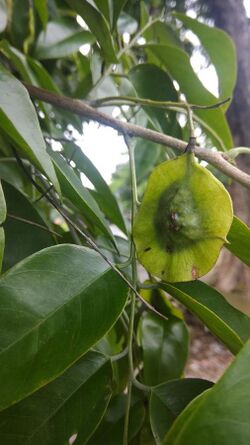Biology:Pterocarpus
| Pterocarpus | |
|---|---|

| |
| Pterocarpus santalinus seed pods | |
| Scientific classification | |
| Kingdom: | Plantae |
| Clade: | Tracheophytes |
| Clade: | Angiosperms |
| Clade: | Eudicots |
| Clade: | Rosids |
| Order: | Fabales |
| Family: | Fabaceae |
| Subfamily: | Faboideae |
| Tribe: | Dalbergieae |
| Genus: | Pterocarpus Jacq. (1763), nom. cons. |
| Species | |
|
See text | |
| Synonyms[1] | |
| |
Pterocarpus is a pantropical genus of trees in the family Fabaceae. It belongs to the subfamily Faboideae, and was recently assigned to the informal monophyletic Pterocarpus clade within the Dalbergieae.[2][3] Most species of Pterocarpus yield valuable timber traded as padauk (or padouk), usually pronounced /pəˈduːk/ or /ˈpædˌoʊk/;[4] other common names are mukwa or narra. The west African species may be traded as African rosewood.[5] P. santalinus also yields the most precious red sandalwood in China known as Zitan.[6][7] The wood from the narra tree (P. indicus) and the Burmese padauk tree (P. macrocarpus) is marketed as amboyna when it has grown in the burl form.[8] The scientific name is Latinized Ancient Greek and means "wing fruit", referring to the unusual shape of the seed pods in this genus.
Uses
Padauk wood is obtained from several species of Pterocarpus. All padauks are of African or Asian origin. Padauks are valued for their toughness, stability in use, and decorativeness, most having a reddish wood. Most Pterocarpus[9] woods contain either water- or alcohol-soluble substances and can be used as dyes.
The padauk found most often is African padauk from P. soyauxii which, when freshly cut, is a very bright red/orange but when exposed to sunlight fades over time to a warm brown. Its colour makes it a favourite among woodworkers. Burmese padauk (ပိတောက်) is P. macrocarpus while Andaman padauk is P. dalbergioides. Padauks can be confused with true rosewoods to which they are somewhat related, but as a general rule padauks are coarser and less decorative in figure. Like rosewood, padauk is sometimes used to make xylophone, organ and marimba keys, and guitars. It is an important material in traditional Chinese furniture.
Some padauks, e.g. P. soyauxii, are used as herbal medicines, for example to treat skin parasites and fungal infections.[10]
Chemistry
Pterocarpin is a pterocarpan found in Pterocarpus spp.[11]
Species
A total of 35 species is currently accepted:[12][13]
- Pterocarpus acapulcensis Rose
- Pterocarpus albopubescens Hauman
- Pterocarpus amazonum (Benth.) Amshoff
- Pterocarpus angolensis DC.—kiaat
- Pterocarpus antunesii (Taub.) Harms
- Pterocarpus brenanii Barbosa & Torre
- Pterocarpus claessensii De Wild.
- Pterocarpus dalbergioides DC.—Andaman padauk, Andaman redwood, East Indian mahogany
- Pterocarpus dubius (Kunth) Spreng. – Venezuela, Guyana, and northern Brazil
- Pterocarpus echinatus Pers.[Note 1]
- Pterocarpus erinaceus Poir.—muninga, barwood, vène
- Pterocarpus gilletii De Wild.
- Pterocarpus hockii De Wild.
- Pterocarpus homblei De Wild.
- Pterocarpus indicus Willd.—Pashu padauk, Malay padauk, New Guinea rosewood
- Pterocarpus lucens Guill. & Perr.
- Pterocarpus macrocarpus Kurz—Burmese padauk
- Pterocarpus marsupium Roxb.—Indian kino, Malabar kino, benga, bijiayasal (w Nepal), venkai
- Pterocarpus mildbraedii Harms
- Pterocarpus mutondo De Wild.
- Pterocarpus officinalis Jacq.
- Pterocarpus orbiculatus DC.
- Pterocarpus osun Craib
- Pterocarpus rohrii Vahl
- Pterocarpus rotundifolius (Sond.) Druce
- subsp. polyanthus (Harms) Mendonça & E. P. Sousa
- var. martinii (Dunkley) Mendonça & E. P. Sousa
- var. polyanthus (Harms) Mendonça & E. P. Sousa
- subsp. rotundifolius (Sond.) Druce
- subsp. polyanthus (Harms) Mendonça & E. P. Sousa
- Pterocarpus santalinoides DC.—mututi
- Pterocarpus santalinus L. f.—red sandalwood, red sanders
- Pterocarpus soyauxii Taub.—African padauk, African coralwood
- Pterocarpus ternatus Rizzini
- Pterocarpus tessmannii Harms
- Pterocarpus tinctorius Welw.
- Pterocarpus velutinus De Wild.
- Pterocarpus villosus (Benth.) Benth.
- Pterocarpus violaceus Vogel
- Pterocarpus zehntneri Harms
- Pterocarpus zenkeri Harms
Notes
- 1 Some sources treat P. echinatus as a synonym of P. indicus.
References
- ↑ Pterocarpus Jacq. Plants of the World Online. Retrieved 1 August 2023.
- ↑ "The dalbergioid legumes (Fabaceae): delimitation of a pantropical monophyletic clade". Am J Bot 88 (3): 503–33. 2001. doi:10.2307/2657116. PMID 11250829.
- ↑ "Reconstructing the deep-branching relationships of the papilionoid legumes". S Afr J Bot 89: 58–75. 2013. doi:10.1016/j.sajb.2013.05.001.
- ↑ "African Padauk | The Wood Database (Hardwood)" (in en-US). https://www.wood-database.com/african-padauk/.
- ↑ The Rosewood Trade: An Illicit Trail from Forest to Furniture Authors: Sandy Ong / Andy Carver, Date: 29 January 2019, URL: https://e360.yale.edu/features/the-rosewood-trade-the-illicit-trail-from-forest-to-furniture (Yale School of Environment)
- ↑ "Zitan | The Wood Database - Lumber Identification (Hardwood)" (in en-US). http://www.wood-database.com/zitan/.
- ↑ "Chinese National Standard for Rosewood Furniture - QB/T 2385-2008". http://www.dyhmjjxhw.com/file/upload/201212/22/16-31-55-12-1.pdf.
- ↑ Meier E.. "The Wood Database". http://www.wood-database.com/amboyna/.
- ↑ "Narra" (in en). https://onetotree.org/narra/.
- ↑ "AgroForestryTree Database entry for Pterocarpus soyauxii". World Agroforestry Centre (WAC). http://www.worldagroforestrycentre.org/Sea/Products/AFDbases/AF/asp/SpeciesInfo.asp?SpID=17977.
- ↑ "Pterocarpin at knapsack_jsp". http://kanaya.naist.jp/knapsack_jsp/information.jsp?mode=r&word=C00009616&key=5.
- ↑ "ILDIS LegumeWeb entry for Pterocarpus". Cardiff School of Computer Science & Informatics. http://www.ildis.org/LegumeWeb?version~10.01&genus~Pterocarpus&species~.
- ↑ USDA; ARS. "GRIN species records of Pterocarpus". National Germplasm Resources Laboratory, Beltsville, Maryland. http://www.ars-grin.gov/cgi-bin/npgs/html/splist.pl?10084.
External links
Wikidata ☰ Q132894 entry
 |



